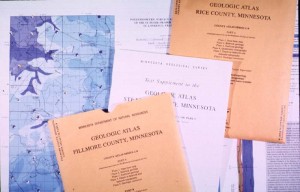Water samples from about 90 wells in Wright County will be collected and analyzed for water chemistry over the next two months by hydrogeologists from the Minnesota Department of Natural Resources. Samples will also be tested to learn how long the water has been underground.
The data are being collected for the Wright County Geologic Atlas, an effort involving staff from the Minnesota Geological Survey, the DNR’s Ecological and Water Resources Division and Wright County Environmental Health.
DNR staff will contact Wright County residents to request permission for well sampling, which involves collecting a water sample and measuring the depth to water in each well. The selected wells will be based on geology, location, well depth, and well construction. The samples will come from wells drawing water from aquifers at varying depths. Owners of wells that are sampled will receive a report of the laboratory results for their well.
 Preserving the long-term quality of the region’s surface water and groundwater requires that policy makers have access to accurate information based on sound scientific principles. A county geologic atlas is a valuable tool used by county planners, resource managers, and other local government staff when making general planning, land use management, and water resource protection decisions.
Preserving the long-term quality of the region’s surface water and groundwater requires that policy makers have access to accurate information based on sound scientific principles. A county geologic atlas is a valuable tool used by county planners, resource managers, and other local government staff when making general planning, land use management, and water resource protection decisions.
The Minnesota Geological Survey has already published Part A of the atlas, which illustrates details of each county’s geology. In 2016, the DNR Ecological and Water Resource Division will publish the groundwater portion of the atlas (Part B). The Part B reports will include maps and descriptions of the hydrogeology, cross sections illustrating groundwater conditions, and the pollution sensitivity of groundwater in the county.
The DNR County Geologic Atlas Program is funded in part by the Minnesota Environment and Natural Resources Trust Fund as recommended by the Legislative-Citizen Commission on Minnesota Resources. Funding also comes from the Clean Water Fund, which receives 33 percent of the sales tax revenue from the Clean Water, Land and Legacy Amendment, approved by voters in November 2008.
A full description of this DNR program and status reports for atlas products can be found online.
For information, contact Jan Falteisek, DNR county geologic atlas program supervisor, at 651-259-5665, jan.falteisek@state.mn.us or John Barry, DNR hydrogeologist, 651-259-5660, john.barry@state.mn.us.